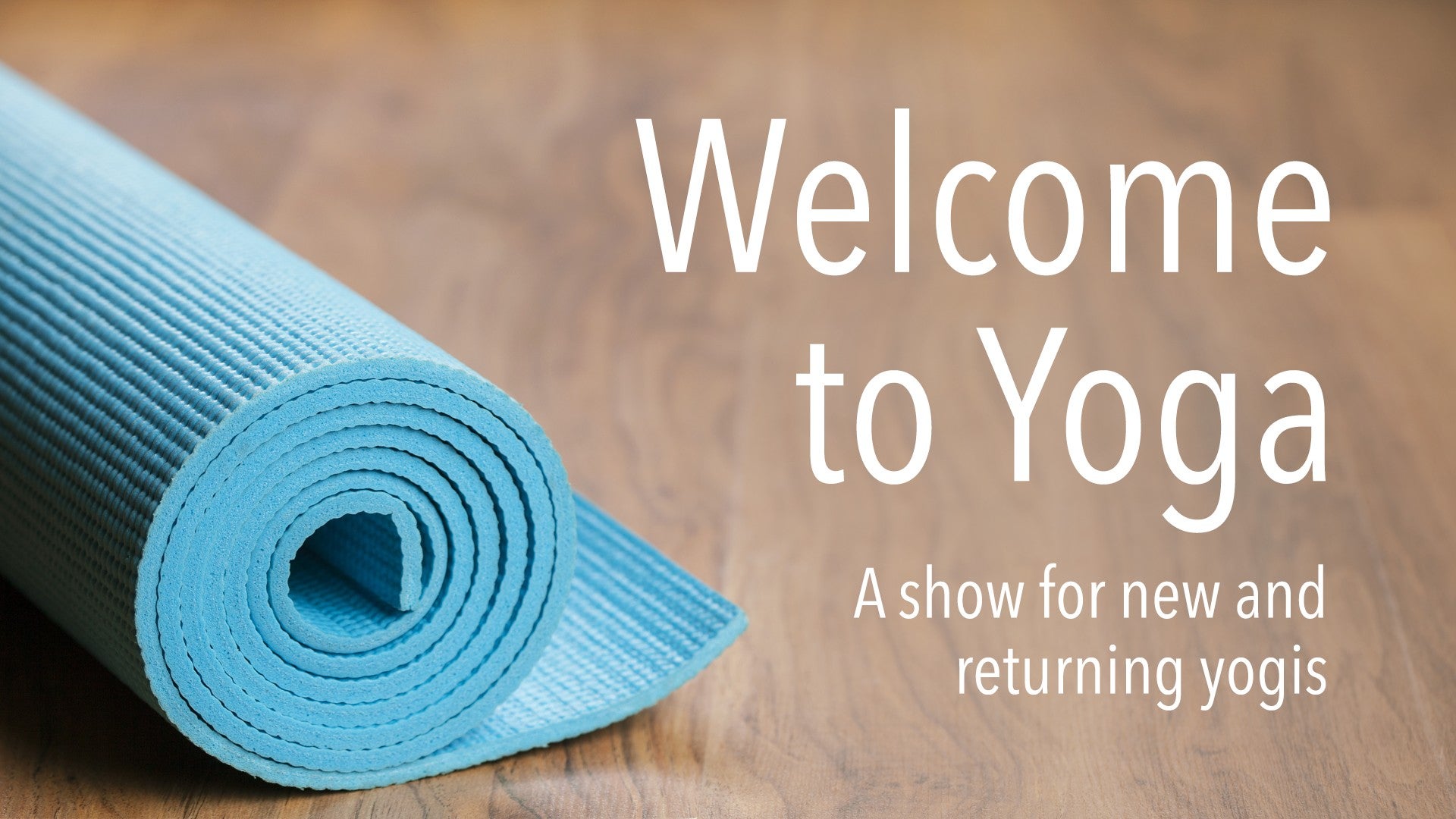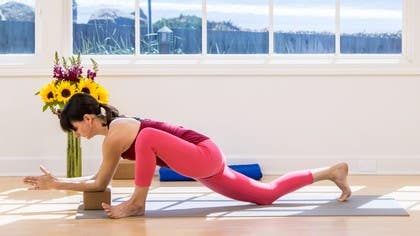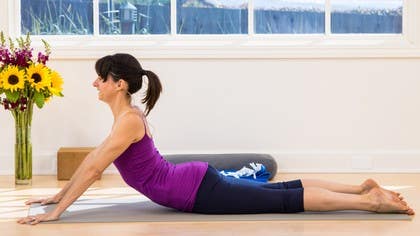Description
About This Video
Transcript
Read Full Transcript
(waves) Hi, welcome to this practice. It is a great practice of some yoga poses that are very common warrior two, side angle, triangle pose, they're poses that open the outer hips and the inner thighs. They are grounding, they create space, they create breath and generally, they tend to make people feel good which is what we're going here. So let's take a moment first, switch the crossing of you legs and make sure that you're sitting high enough that you feel comfortable, if you're unclear about how to sit you can refer back to my tutorial and finding a good comfortable seat. Close your eyes.
There's an image that I often work with in my practice when I first come to it and it's this image of my body with extension cords coming out of it in all different places and they're all plugged in. One is plugged into my work. One is plugged into my kid. One is plugged into my emails I haven't written. One is plugged into the dishes sitting in the kitchen sink and one is plugged into the upcoming elections and the problems in the world and I'm plugged in and then when I come to my practice I get to kind of systematic pull those plugs and come to myself and in a sense, there's a simplicity of letting go of all the strenuous and important things in your life and just giving yourself a little time to be with yourself.
Aligning your mind and your body. Give yourself the opportunity to unplug. And in that perhaps, you find some relaxation. Let's put one hand onto the heart center. In yoga, we often talk about the heart but we don't mean the actual heart which is on the side, we're talking about the (foreign language) heart center.
Put your other hand onto your belly and just take a few breathes. Feeling your own self beneath your hands. The Buddhists always talk about the body as being this precious human body. Invite your breathe to be long and smooth. The breathe will hold your hand through this practice and beyond.
And then just changing the breathes into a sound, we'll make the sound of OM, as a way of further arriving, further unplugging, further finding presence in our bodies, let's join the hands. Rest your thumbs onto your breast bone. Exhale your breathe and then take a deep breathe in. (elongated OM's) Bow your head towards your heart. Just take a moment to thank yourself for coming to your yoga mat and then lift your head, open your eyes and extend your legs out in front of you.
Separate your feet a little bit. You can lean back onto your hands like you're hanging out at the beach and then we're just gonna explore a little bit the rotation of the legs. You're gonna roll your legs out and then roll your legs in. I know you see a lot of movement in my feet but the movement is actually coming from the very top of the thigh bone, fitting into the hip socket. I thinking about that big Flintstone like thigh bone rolling in and out in the hip socket.
The hip socket is called the acetabulum and this is a little yoga anatomy trivia, it's Latin for vinegar bowl. You're letting that thigh bone move around in the slippery vinegar bowl. You can notice for yourself, if you rotate more out or you rotate more in, everybody is different and it mainly depends on the shape of your bones. Everyone has their very own personal thigh bone, very personal hip socket, vinegar bowl so it's individual, nothing to blame, doesn't matter. We're just observing.
We're gonna bring the legs to parallel and then draw them in, in this parallel position and then, open the thighs to the side which is external rotation, the thigh's rolling out. This pose is called baddha konasana. You can keep your hands behind you, if you have shorter arms your hands might be up onto your blanket or whatever you're sitting on and just take a moment, close your eyes. Lift your spine, drop your sitting bones and let your thighs become heavier. Invite some breathe to drop down into your hips.
And notice if one hip feels a little more gripped or a little tighter than the other. If you find that to be the case, by based on what you perceive, put your attention into the tighter more gripped hip. There's actually a scientific principle called the Hawthorne effect and it states that, when you notice something, it changes. Just by paying attention to the hip joints, there could be some release or some relief that happens. We're gonna lean over to one side and use the opposite hand, press long, like you're ironing from your inner thigh to your inner knee, creating a feeling of length through the inner thigh, the inseam of the leg.
Go to the other side, iron inner groan, top of the groan out to the inner knee. We're not as much pressing down as trying to create length. Go from side to side a few more times. Again, you can notice if one side feels different than the other, it's very normal to be imbalanced but in this yoga practice we do work to try to find a little more symmetry in the body and in the mind and in the soul. I want you to remember this feeling 'cause I'm gonna refer to it later of the length from the inner groan to the inner knee.
Use your hands to gather your knees together and we will transfer onto hands and knees, putting the props neatly to the side, keeping your space clear is a way to keep your mind clear. Spread your fingers, root the palms, place the index fingers straight forward, sense length from your head to your tail and we're gonna take the right leg back. Let's put the toes on the floor first and then find a little stability from your abdomen towards your spine and float your right leg up off the ground. And then shift your weight onto your right hand until your left hand becomes light and float your left hand up off the ground. If this feels too alarming, if you can't breathe, if you start getting emotionally rattled, we don't come to the yoga mat for that so you would adapt, you'd put your foot down, put your hand down, make it work for you.
Then from here, the hand comes down everybody and the right foot comes down and then we're going to externally rotate the back leg. So the thigh bone externally rotates and that delivers the sole of the right foot to the ground. See if you can get the ball of the big toe and the ball of the little toe pressing into the ground and then the center of the heel. And pull your left hip underneath you, turn your belly, turn your chest and reach your right arm straight up towards the sky. Keep the right foot anchoring to help you balance and then turn your right palm away from the wall and reach your right arm up over your right ear and really lengthen and stretch from your right foot to you right fingertips, two breathes, inhale.
Exhale one, the left hip is pulling underneath the pose. The abdomen is turning, inhale and as you exhale, mindfully precisely put your right hand onto the ground. Make your right leg come back to parallel and then bring your right knee to the floor. Second side, left leg, first toes on the floor, putting your toes on the floor helps establish a clarity through the leg and then float, and think about the inner leg coming up. The whole leg will come up but we wanna keep it parallel.
So guiding, leading by the inner leg is helpful. Shift your weight to your left hand. Find your right arm perhaps floating up. If it's challenging you breathe. If the breath doesn't work, you modify.
And then the right hand down, left foot down. The left leg externally rotates which delivers the left heel done to the ground and then pull this right hip underneath you. That will begin the belly turning, the chest turning and the left arm reaching up. Turn your left palm away from the wall so that arm is externally rotating for the record and reach the left arm up and over the left ear. This is a variation of a few poses but we could consider it a variation of extended side angle.
Really extending the spine, extending the leg and the arm and the spine. One more deep breath here. And as you exhale, hand down, heel lifts, bring your knee down and then widen your knees and little bit wider than your hips, bring your big toes together, press back into child's pose. This child's pose, let's keep the arms reaching forward, extending forward. If in child's pose, your head doesn't make it to the ground, take time to put you forehead onto a block.
If it's challenging on your knees, you can take a blanket and put it behind the backs of your knees so prop up to make this useful and helpful for you. Coming out of child's pose, come onto your hands and your knees. And then again, go a longer stance. Hands about four inches forward, tuck your toes and then lift your hips up and back into downward facing dog. Adjust your hands so the index fingers are pointing straight forward.
Feel your arms like drinking straws pulling energy right up from the Earth into the shoulders. Lengthen through the spine. Pull the sitting bones back away from the rooting of your hands and then walk your hands back to your feet. From here, bring your hands to the very tops of your thighs. Lengthen your spine and then come all the way up to stand.
Then we're gonna move into this side facing standing poses. Probably will be helpful to have blocks. Although, there are versions you can do without blocks. Put the block something like that and then I'm gonna stand with my feet wide on the mats. How wide, it depends but a good sort of overall rule that works for most people is to have the feet underneath maybe the wrists, when you reach you arms out to the side.
And then let your arms come down. And we'll take the right leg and turn the whole right leg so it looks like it's the foot but it's really the thigh. The thigh turns, the result is the foot. Make sure your right foot is pointing absolutely straight away. Bring your hands to your pelvis.
See if you can have your pelvis level so the right hip and the left hip, not tilted forward but level, right hip and left hip even. And then look at your right kneecap, if it was an eyeball, you would want it looking straight forward not in, which is the tendency. Chances are for most of us it's best to turn the pelvis slightly on an angel so that the right knee can then point straight forward without any strain on the low back. Take your right hand bring it to your right inner thigh like we ironed in baddha konasana, iron the inner leg as you bend the knee into warrior two. Float your arms out to the sides.
In warrior two have your right foot straight away, right knee directly over the right heel, the right thigh bone is moving down, it's moving towards parallel to the ground but it's okay if it doesn't go all the way today. The gazes gently rests over the right middle finger. Feel a little bit of abdominal support so that there's a fullness in your low back and then from there feel the whole spine just lifting lengthening away from the heavy tailbone. Two deep breaths, inhale. Exhale one, reaching back through the left hand, awareness back through the backhand, inhale.
Exhale two. As you inhale, straighten your front leg. Release your hands, turn your right toes forward, whole left leg turns out and again we'll iron inner thigh to inner knee. As I've said in an earlier taping, when something's going in one direction, something's always coming in the other direction. You can also think outer knee sucks back into the outer hip.
Float your arms up. Pelvis is on a slight diagonal, back leg's straight and strong, the low belly lifts, tailbone is heavy and the spine lengthens from the stability of the legs. As you breathe, let your awareness spread, inhale. Exhale one, maybe let the left thigh sinks a little deeper, inhale, exhale two. As you inhale, straighten you front leg.
Bring you hands to your hips, turn your left toes forward and then step your feet together. Just stand for a moment. Feet can either be right together or a little apart. Just observe how you feel. And the next pose, a very similar pose but it looks different but anatomically it's pretty similar as tree pose.
So we'll bend the right hand on the wall. We'll bend the right knee and just open your right thigh to the degree that you can without turning your pelvis. And then the heel can come right to the inner ankle or you can slide your foot to the calve or you can pull it up to the inner thigh and then let's skooch in so that the right knee is touching the wall. Again, for most bodies they won't be straight to the side. For most bodies the thigh is somewhere on the diagonal so that the pelvis can be straight on and level.
You can check that for yourself, look down, levelize your pelvis and then look forward. Bring your hands together in front of your heart. There's a strong tendency here to look down, to lose the head, to get a little nervous balancing on one leg but see if you can lift your chest and let your head float up. Feel your inner thigh lengthening to your inner knee. As the outer left hip comes in and supports the pose.
You can put your hand onto the wall and step down. We'll do the second side tree pose with the knee against the wall again, it's fine to do with the heel on the inner ankle and the toes on the ground, I'm gonna do it that way on this side. Hands in front of the heart. Bring your hands to your pelvis, look down, make sure you haven't turned your pelvis, keep your pelvis even. Bring your hands in front of your heart.
Root clearly through your right foot. Left inner thigh to inner knee. Outer thigh pulls back into the outer hip. And then after all of the details just pause, let your breath deepen, let your awareness spread. And then release mountain pose.
And take the feet wide again like we had them before. Take the right leg, turn it all the way out and for trikonasana triangle poses next so we're gonna let the left heel slide back slightly so the back foot is on a very slight angle. And then bring your hands right to the very tops of your legs, where your legs meet your pelvis and in this pose it's a little bit like a high fashion model. You want the pelvis to click over into position like that. This image seems to resonate for most people I've taught all over the world, this idea of the fashion model.
So you let the pelvis tip to the side. The spine goes with the pelvis, the spine is a result of the pelvis tipping. So tip, reach your arms and then keep the pelvis tipping. This is where it might be nice to hold onto one of your blocks, having the block right beneath your right shoulder and the left arm reaches up. Much like warrior two, now it's a slightly different look but this left hip, you don't wanna pull it back and compress the low back, let your left hip move forward slightly so your right knee can point straight forward.
Keeping that roll, your right side of your belly to the left side of the belly. Let there be a turn, only if it's very comfortable on your neck you can look up towards your left thumb but for most people, it feels better on the neck to look forward, I always think it's sad whoever designed this pose, designed it looking up because a lot of people have strained their neck from trying to copy pictures and we don't wanna copy pictures in this practice, we wanna find our individual alignment, our individual expression of each pose. Trikonasana, inhale come up, release your hands, right toes turn forward and in the whole left leg turns out. This time I'm gonna float my arms up first and then model tip my pelvis over to the side, come down, find my block, if you don't have blocks, it's perfectly fine to put your hand on your shin but you don't wanna push too much into the shin 'cause that could jam into the back of the knee but a light resting of the hand onto the shin is fine or a block, if you happen to be very flexible, hand to the floor is okay but not if you reach down and can lose your alignment, you wanna keep the clarity that you know through the legs, the turn of the spine and the extension of the arms, trikonasana. Breathing, feeling of the tailbone lengthening to the back heel as the crown of the head reaches away from the back heel.
And then rooting into your feet, inhale. Come all the way up, hands to the hips, left toes forward. We're gonna rest in a forward fold called prasarita padottanasana. Take your elbows back, lift your chest, lift your heart coil up. As you exhale, keeping your legs firm, come half way forward, breathe in here and as you exhale, let your spine keep releasing forward.
If the floor feels far away, you have your blocks, feel free to put your hands onto your blocks. Another option which I'd like for you to do if you can reach is to hold on either to your ankles or your outer knees, let your head go down, lift your shoulders up so you have a nice long neck, take your elbows out wide to the sides. Lift your toes, spread them wide, not only the toes but the arch of the foot spread wide. The center of each heel plummets into the ground. And then bend one knee, stretching the inseam of the other leg, long inner thigh that we're talking about in this practice and over to the other side.
Just go back and forth a couple of times. Feeling the shift of the weight, feeling the length of the opposite inner groan. And then bring yourself to the center. Hands to the hips, inhale half way up, pause and then inhale all the way up and let's take a minute to bring the feet together. Bring the hands together, sometimes I like to rest the center, between my eyebrows on my thumbs and bow the head a little bit.
Inviting my brain to soften. Continuing to unplug if a nagging thought comes my way. And then release. We're gonna do one more standing pose in this series. I want my blocks at the ready once again.
Same beginning, wide feet and we'll turn the right leg out. This one is extended side angle. It's a cross between warrior two and triangle pose. If those two had a child, it would be this pose. So this is the baby of warrior two and triangle pose.
So warrior two, before I go into it, just to get length on the right side of my body I'm gonna put my left hand onto the left hip and reach back into reverse warrior. And then the pelvic tip, remember the model pelvic tip begins to come into play here. Options, if you're not using blocks, forearm onto the thigh is a wonderful, very convenient option or the hand can come onto a block at any height. Left arm straight up towards the ceiling. Turn your left palm to face away from your left foot and then reach the arm up and overhead.
It's convenient that I have a wall here so I can feel the wall underneath my hand. Doesn't matter if you have a wall or not with the feeling of really reaching into something, the left foot pressing down, the right thigh sinking, the left thigh strong and the abdomen turns and I'm breathing and I'm feeling and I'm unplugging. Again, you always wanna find a place for you neck that feels healthy for you. Inhale, come up, right toes turn forward, left toes turn out, inhale your arms up. Exhale this time have a feeling of dropping into warrior two let the thigh really just drop down.
Reverse warrior, whole left side of the body open and then the pelvis begins, begin to tip the pelvis like a big steering wheel, turning over the thigh bones, form to the thigh or the hand to a block and then the right arm reaches up. Right palm turns away from the right heel and then extend your right arm up and over your right ear. Let the shoulders slide away from the ears. The shoulders actually do go up when the arms go up but you don't wanna overdue that. Like anatomically, the shoulders do lift a little but we don't wanna overdue that.
There should just be a little weight on your left hand. You could pick it up if you needed to. Breathe, expand, open, feel, soften. Inhale, come up, turn your left toes forward, step the feet together and let's take a moment just resting forward in uttanasana, holding onto the elbows, releasing the spine. Resting, breathing.
Hands to hips, inhale half way up and then come all the way up to stand. We are now going to put those poses together in a little bit more of a flowing style. The way I just taught them is more one might say, like an iyengar style where you just work really on alignment and go precisely from pose to pose and then there's a whole school of yoga that flows sometimes called vinyasa or flow, hatha flow. We're just gonna give a little taste of that with the poses that we just worked on. So let's step to the front of the mat.
And we'll begin with tree pose. So the right knee bends and opens since we're away from the wall now you might wanna keep your toes rooted on the ground and place your heel into your inner thigh. If you're feeling adventurous, bold today, you might pull the foot up higher. Hands in front of the heart. In tree pose, you are quite likely to fall over.
It's a balancing pose, we're on a world that is spinning very fast, the world is like this so if you fall out the art of tree pose is to just bring yourself back. Bring your right knee forward. This is gonna be an exciting move. We're gonna bend the left knee, reach the right foot back, way back, super bold, high lunge, reach your arms up overhead. From here, remember the ironing of the inner left thigh as you open into warrior two.
Keep the left knee tracking right over the center of the left foot, inhale, straighten your front leg. Exhale, the pelvis tips bringing you into triangle pose. Inhale, come right on back up. Exhale, bend the front knee, warrior two. Breathe into reverse warrior, stretching the left side of the body.
Exhale, side angle, tailbone reaching to the back heel. Inhale, reverse warrior and as you exhale, big child like cartwheel with the arms, all the way down to the floor. Lift your back heel, step back downward facing dog. As you inhale, come into plank position. Knees to the floor, lower to your belly.
Inhale, point your feet, just lift the chest a little, opening the heart center, pull back downward facing dog and then a hand walking meditation, walking the mindful hands all the way back to the feet. Bend your knees, roll up to stand. Foot walking meditation to the front of the mat. Second side, tree pose, second side might be very different than the first, so go into it with the beginners mind. Left knee comes forward, let your upper body go forward as you reach your left left way back, fall into your high lunge, take a breath in, make sure your right knee stays tracking straight forward as you open into virabhadrasana two.
You can wiggle adjust your feet if need be. Inhale, the front leg straightens. Exhale, the pelvis tips into triangle pose. Breathe in, come on all the way back up. Breathe out, inner thigh to inner knee, warrior two.
Inhale, big arch back into reverse warrior. Exhale brings you into the side angle, it's the pelvis rotating over those thighs. Inhale back into reverse warrior. And here we go with our big arm cartwheel. Down, downward facing dog.
Three breaths, inhale. Exhale, flutter your lips. Inhale, exhale, stick out your tongue. Last breath, fill your whole body with the inhale. And exhale.
With your next inhalation, come forward into plank. Maybe this time the legs stay straight as you lower or it's also completely fine to lower the knees to the ground first, come to your belly and then roll over onto your back. Have a blanket nearby and then lift your pelvis, slide the blanket underneath your pelvis and lower your pelvis back down. Laying on your back sometimes takes a little hairdo adjustment, if you have a ponytail you might wanna take it out. From here, just gently draw the shoulders down and under and then bring your knees into your chest and lift your feet up into the air.
It's perfectly fine to keep the knees bent. You don't wanna have abdominal gripping or strain in the low back in this version of shoulder stand. After the standing poses and so much important vigorous work down into the legs, it's a beautiful part of yoga that we turn upside down and you can just notice how it feels to have your feet in the air and your head on the ground. Maybe you have a sense of the blood of a lymph fluid, the water in your body moving from your toes towards the Earth. It's also completely fine if you don't feel that.
I want you to give yourself permission to have your own experience in your practice. We're gonna let the feet come back down to the ground. Let's just keep the pelvis lifted onto the blanket but shift your pelvis about five or six inches over towards the right side of the blanket. So you're gonna be twisted for a moment and then bring your knees in and take your knees over to the left, your left hand can rest onto your legs, your right arm can open to the side. As you exhale, let the right top of the lung and the right shoulder grow a little heavier into the ground.
And see if you can really acknowledge that you're quite fully supported in this pose. The pose will do you if you just release. You don't have to do it, it will do you once you come into the position. And pour your breath into your skin. After your next exhalation, come to the center.
The shifting of the pelvis is so that when we come into the twist, we're aligned with our head and our heart and our pelvis, in a straight line. Knees in and then carry your knees over to the side. Soften the pit of your throat. With each exhalation, let the left shoulder blade grow a little heavier. Notice every sensation, let your mind come into those sensations.
We use our body in yoga as a meditation. The mind resting on what we feel. Come to the center, bring your pelvis to the center, draw your knees into your chest and then one more, we've done all this inner thigh opening. Let's let the legs open to the sides, let your hands rest onto your inner thighs or inner knees. Send your pubic bone away from your navel so the low belly is long and reach from your right sitting bone to your right heel, your left sitting bone to your left heel.
From here, bend your knees, reach up, hold onto your ankles or the outsides of your feet and having the blanket here underneath the low back makes it a little easier to reach up towards the feet. But then, try to release your sacrum, your low low low back down towards the blanket as you pull your thighs down towards the ground. Just two breaths here, inhale, exhale one. Inhale, exhale two. Release your feet to the floor.
Lift your pelvis, move the blanket to the side and then extend your legs for shavasana. If you have any low back discomfort at all, put the blanket underneath your knees, that usually relieves that discomfort. It's also fine to put a blanket underneath your head or I always like to put my blanket right on the tops of my thighs just to help ground and release. You wanna set your corpse pose, shavasana up with the tender care that you set up your other poses. Feel free to move around a little bit until you find a place where you can commit to being still for a few minutes.
Relax every muscle of your face. Let the sides of the neck fall towards the Earth. Very soft. And then bring your attention down into your abdomen. Many of us carry a fair amount of tension in the belly and now is a time to practice letting that tension free.
The ancient yogis assigned different elements to different body parts and to the belly they assigned the element of water, so as you relax your belly, see if you can feel like it's a nice clear pool of easy fluid. Relaxing from the skin, through all the muscles, down into the low back. And from the (mumbles) of the hips, feel your legs flowing like two rivers, moving in the direction of the ocean. The legs linking the ocean to the soft belly. And let your whole self do a little bit less and less.
Continuing to release the weight of your body, soften your face, your heart, your abdomen. Begin to deepen your breath. Let the deepening of the breath, gently pull your attention back to the surface. And let your thumbs just touch the tips of your fingers. Feel the sensitive nerve endings in the tips of the fingers.
And then let your toes wiggle, your feet move around a little bit. And rock your head from side to side. You're welcome to stay longer if you're ready to come up bend your knees, roll over to your side. On your side here, see if you can stay out of any habit you may have of rushing, give yourself a real moment to sink into this side shavasana. As you're ready, press down into the floor and make your way up to sit, take time to get your props aligned for your seated position.
Once you come to your seat, lift your heart. Observe how this practice has effected you today. Bring your hands in front of your heart. We've all heard the word nomaste, it means literally nom means bow, as is me and te is you. So very, from the bare bones it's I bow to you but the connotation that it is used nomaste is the lightness, the goodness, the joy in me also sees that in you and in that we're one.
We both have these qualities of bright open light. We get to negate the aspects of our personality that still need a little polishing. So nomaste, thank you so much for joining me.
Welcome to Yoga: Explore the Fundamentals
Comments
You need to be a subscriber to post a comment.
Please Log In or Create an Account to start your free trial.













